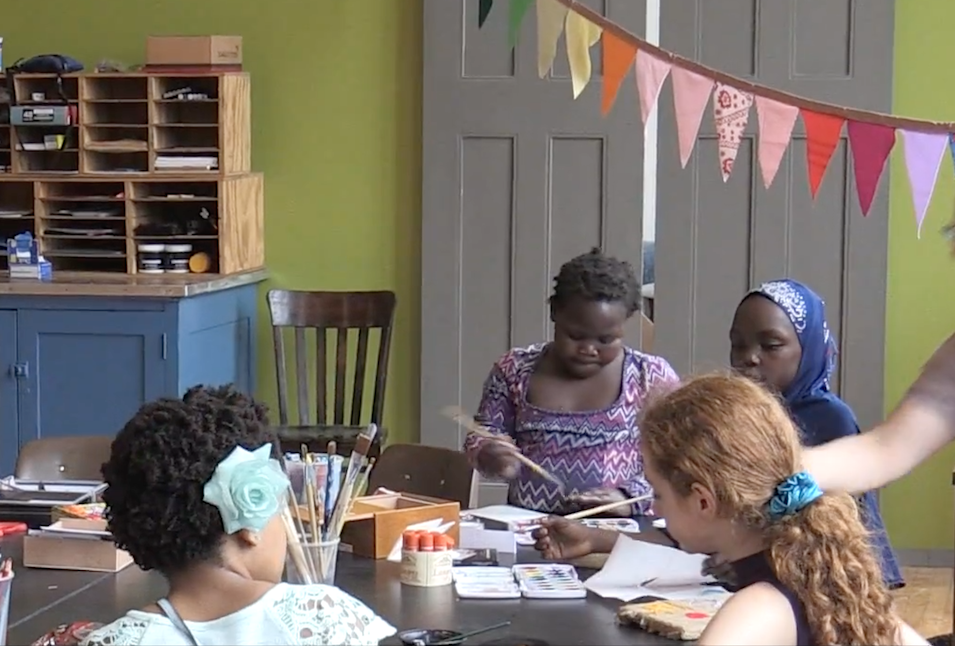
Everyone is an artist and all are welcomed with radical hospitality in Art Hives. Now, the community art studios are popping up in the St. Louis metropolitan area thanks to Southern Illinois University Edwardsville and community partners.
“With SIUE/STL Art Hives, we are empowering people to come up with their own way of expressing themselves by providing materials and tying art therapy into a community model,” said SIUE art therapy counseling graduate student Theresa Hitchcock.
Art Hives is an open-source model pioneered by Janis Timm-Bottos, an art therapist and associate professor at Concordia University.
SIUE’s Shelly Goebl-Parker, associate professor in the Department of Art & Design’s art therapy counseling program, along with colleagues across campus and art therapy counseling graduate students, have now put SIUE/STL Art Hives on the map. Its first pop-up studio event was held in May at the Intersect Arts Center in St. Louis. View a video of the event here.
“As a social worker and art therapist, I am used to community practice being a dimension of my work,” Goebl-Parker explained. “Art Hives has been a way for me to share the theoretical aspects and best practices of community-based work with my art therapy counseling students and colleagues.”
“The model was appealing to me, because it offers a way to connect with children, families and groups of people who may not otherwise have regular access to art materials,” she added. “We’re sort of plopping resources in their path and making them available. Then, we work with people to develop whatever it is that the community needs.”
Art Hives’ core principles include consensus decision making, solidarity, positive kind regard, radical hospitality, everyone an artist and each one, teach one.
“Art Hives is all about a democratic process, so each person has power in themselves to teach another person,” said SIUE art therapy counseling graduate student Kay Guyer. “Art making for me is a powerful way to connect with others. It’s its own language. I appreciate the opportunity to facilitate these spaces and be in practice here. This is what I want to do in the world, and I’m doing it right now as a student.”
“We bring materials and facilitators, but that doesn’t necessarily mean we’re teaching someone how to do art,” Hitchcock added. “We’re welcoming people into this space and encouraging them to pull out their own creativity and share that with others. We’re creating an opportunity rather than applying pressure.”
Goebl-Parker emphasizes the rich community arts scene already in place throughout St. Louis from which she is collaborating with more organizations and groups to expand the Art Hives pop-up studios, and build on the great work happening in the area.
“It’s exciting for our students to be able to take their talents and capacities and meet the community at a ‘What does the community need?’ level,” she said. “This initiative is about using art to be a positive force in the community. Art Hives offer a public version of the kind of work we often do in privacy when we’re doing therapy.”
“We’re excited about the possibilities that exist,” Goebl-Parker added. “SIUE/STL Art Hives naturally took off, and that’s a sign of something that is happening in the right place at the right time.”
This summer, Goebl-Parker is also teaching a community arts class at SIUE. Students will be embedded in community arts organizations where they will learn from organizations doing impactful work about how to build and design programs that achieve good outcomes.
“In our summer course, we have students majoring in not only art therapy, but also studio art and public policy. Community work is an interdisciplinary practice, so I’m excited to have these students coming from different angles and engaging in these high impact community practices. Collaboration is really what makes the magic happen and we’re experiencing that with SIUE/STL Art Hives.”